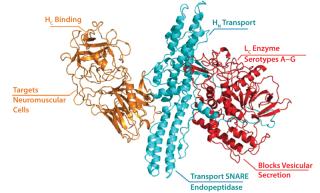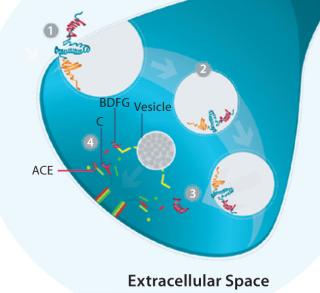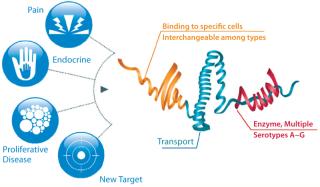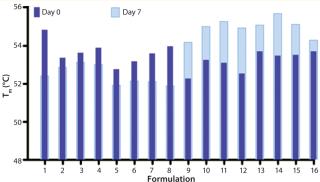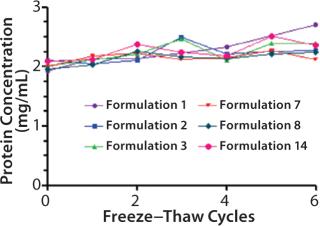Our company carried out a preformulation study on a recombinant targeted secretion inhibitor (TSI) with contract research organization (CRO) Avacta Analytical. In this protein, the binding domain of botulinum toxin is replaced to broaden the toxin’s therapeutic potential and allow drug development to be targeted towards a specific disease. In our study, we took advantage of the high-throughput, microvolume protein analysis of Avacta’s Optim 1000 fluorescence and light-scattering instrument (which is distributed in the United States by Pall Corporation). It significantly reduced the volume of material required for testing and enabled large amounts of data to be acquired in a relatively short period of time.
Preformulation TestingPreformulation studies are a vital stage of drug research and development. They fully explore the physical, chemical, and mechanical properties of a candidate drug to enable a stable, safe, and effective formulation to be produced. During this phase of drug development, the physicochemical parameters, kinetic rate profile, physical characteristics, and compatibility of a drug candidate with common excipients are established. Scientific data are collected to support a final drug formulation and help evaluate the efficacy, stability, and bioavailability of a final product.
PRODUCT FOCUS: PROTEINS
PROCESS FOCUS: FORMULATION
WHO SHOULD READ: FORMULATORS, PRODUCT DEVELOPERS, ANALYTICAL
KEYWORDS: LIGHT SCATTERING, STABILITY, FLUORESCENCE ANALYSIS, OUTSOURCING, AGGREGATION, MECHANISM OF ACTION
LEVEL: BASIC
Undertaking such studies requires significant resources to enable obtaining the necessary data as quickly as possible. That presents a number of challenges. The large quantities of high-quality material required for preformulation testing may be difficult to obtain. Early development stages present a high demand for such material to cover the full range of investigations. Quite simply, the more formulations assessed, the more material is needed. Because the related analytical techniques are normally destructive, that material often cannot be reused. Here, we report how Syntaxin outsourced preformulation studies of its SXN101959 TSI molecule to Avacta Analytical. This allowed the company to take advantage of Avacta’s innovative Optim 1000 high-throughput, microvolume protein analysis system in performing these analyses.
BackgroundSyntaxin was founded in November 2005 through a spin-out of intellectual property and scientists from the United Kingdom’s Health ProtectionAgency. The company is using its expertise and proprietary technology to design and develop a class of biopharmaceuticals known as TSIs. Synthesized by microbial cell culture, these biological molecules are novel recombinant proteins designed to specifically target defined cells and inhibit certain secretions from them to treat a particular medical condition involving those secretions.
Vesicular secretion is a key part of how cells interact with each other and their environment (1), with a significant causative or contributing role in a diverse array of diseases and medical conditions. Neurologically, those include the release of acetylcholine from peripheral motor nerves, which drives the muscle contraction involved in many movement disorders and spastic conditions, and the release of neuropeptides and neurotransmitters from synapses of nociceptive afferent nerves. Hormone release by endocrine cells is a major regulator of metabolism, and its dysfunction underpins a wide range of metabolic and endocrine disorders. Secretion of hormones and growth factors — both paracrine and autocrine — also plays a significant role in the development and maintenance of tumors.
Botulinum neurotoxin is a potent inhibitor of the vesicular secretion of neurotransmitters from nerve cells, so its endopeptidase activity forms the basis of Syntaxin’s TSI technology. This endopeptidase inhibits the action of soluble N-ethylmaleimide–sensitive factor activating protein receptor (SNARE) proteins, which are essential to the docking and fusion of vesicles with membranes for vesicular secretion. Syntaxin’s new TSI class derives from the design and generation of novel recombinant genes encoding proteins wherein the neuron binding domain of botulinum neurotoxins is replaced by a new ligand specific for a selected cell type (2). This allows construction of novel recombinant proteins that target specific cell secretion pathways, producing reversible, noncytotoxic, long-acting cell secretion inhibitors for clinical applications.
OutsourcingOnce Syntaxin has created a TSI, the molecule must of course undergo preformulation studies to fully explore its properties. Performing in-depth studies in house requires considerable investment in both equipment and staff time, so outsourcing can be a more cost-effective way to proceed. Syntaxin chose to focus its efforts on research and development and use a strong outsourcing model to takeadvantage of external equipment and expertise. That has allowed the company to develop valuable, long-standing partnerships with CROs that fully understand its technology and function like an extension of Syntaxin’s own research division. Preformulation studies of the SXN101959 acromegaly drug were outsourced to Avacta Analytical. That provided Syntaxin with the benefit of the CRO’s ability to perform rapid, high-throughput preformulation studies using very low sample volumes on its Optim 1000 microvolume protein analysis system.
The instrument uses 266-nm and 473-nm lasers to simultaneously acquire intrinsic protein fluorescence spectra (a probe of tertiary structure) and static light-scattering data (a probe of protein aggregation) from up to 48 ultralow-volume samples. Those samples also may be heated to explore the thermal stability of proteins in different solvent environments.
Avacta Analytical specializes in characterization, formulation, comparability, and stability studies of recombinant proteins and antibodies for the biopharmaceutical market. The company combines expertise in the biophysical analysis of proteins and peptides using traditional analytical techniques with the new proprietary instrument. Syntaxin values the bespoke biophysical characterization service supported by scientific guidance — including guidance on selection of formulations and data interpretation — that meets the demands of early drug development.
The Optim 1000 system played a key role in these preformulation studies. To be suitable for formulation and manufacture, a protein must remain stable as a homogeneous solution. Determination of a protein’s aggregation onset temperature (Tagg) and protein unfolding or melting temperature (Tm) is a crucial part of such evaluations. The results enable the most stable formulation candidates to be selected and evaluated against parameters such as pH, salt concentration, and excipients. The Optim 1000 instrument is designed to use sample volumes as low as 9 µL, and it consumes significantly less material than do traditional techniques in generating Tm and Tagg values. For Syntaxin this was a major benefit, eliminating the need to provide large amounts of material and enabling unsuitable formulations to be discarded early in screening.
TSIs and Botulinum NeurotoxinTSI technology is based on the botulinum neurotoxin, which is widely used in medical and cosmetic products. Seven different serotypes of this neurotoxin exist, all of which inhibit acetylcholine release from nerve terminals. But their intracellular target proteins, mechanisms of action, and potencies vary considerably.
Botulinum neurotoxin consists of one heavy chain and one light chain. The expressed single-chain polypeptide is activated by proteolytic cleavage into a 100-kDa heavy c
hain (HC) and a 50-kDa light chain (LC) linked together by a single disulfide bond. Three distinct protein domains play a key role in inhibiting vesicle fusion in target neurons (3, 4): a binding domain (Hc) and a membrane-translocation domain (Hn), both located in the HC, and an endopeptidase domain located in the LC (Figure 1).
The binding domain is responsible for high-affinity selective binding to target neurons. It links to the membrane translocation domain by a peptide bond. Noncovalent interactions and a disulphide bond connect the latter domain to the endopeptidase domain and assist in its entry into a cell’s cytosol, where it cleaves SNARE proteins. Found in vesicle and cell membranes, SNARE proteins are involved in vesicle docking and release, interacting with a vesicle to enable secretion of its contents. By cleaving those proteins (Figure 2), the endopeptidase prevents formation of a productive SNARE complex and inhibits neurotransmitter secretion (5,6,7). The duration of that inhibition can range from less than a month to over six months depending on the LC and the specific SNARE protein that is cleaved.
TSI Technology: The selectivity, potency, and prolonged activity of botulinum neurotoxin can produce a profound therapeutic effect when delivered locally. However, its clinical use is limited to selected disorders of the peripheral nervous system because the endopeptidase is effective only in specific neuronal cell types due to restrictions of its natural targeting domain. By contrast, TSI technology is not restricted to the same limited cellular population. It enables cell-specific targeting through a suitable targeting domain to receptors or cell surface markers of restricted distribution on a cell type of choice. That reduces the potential for off-target effects and ensures that delivery of the endopeptidase (and subsequent inhibition of secretion) occurs only in the intended target cells (8). So unlike clinical botulinum neurotoxinproducts, TSIs can be delivered safely through systemic (as well as local) routes of administration.
The creation of TSIs (Figure 3) involves replacing the part of the neurotoxin that binds to nerve cells — its Hc domain — with a targeting moiety such as peptides or protein ligands to cell-surface receptors as the binding domain to create a targeted recombinant protein (9). Alternative binding approaches such as antibodies, antibody domains and fragments, and other binding scaffolds complement this approach and open up categories of cell-surface binding sites not suited to traditional receptor–ligand approaches as well as receptors to nonpeptide ligands. Syntaxin has demonstrated that the TSI platform is suited to incorporating a range of such novel binding approaches. Careful targeting of cells allows intracellular delivery and stops secretion occurring, enabling TSIs to be directed against any disease that has secretion as an end point (10). Potential applications include pain, endocrinology, and oncology.
Cell-Specific Targeting: One particular condition likely to benefit from TSI technology is acromegaly, which is commonly caused by a somatotrophic adenoma — a tumor that secretes growth hormone (GH) — of the anterior pituitary gland. Characteristic clinical features result from high levels of insulin-like growth factor-1 (IGF-1) and GH (11). Syntaxin has used its TSI technology to create SXN101959, a specific molecule that selectively targets pituitary somatotroph cells through receptor binding, then internalizes and cleaves the target SNARE protein. That inhibits secretion of GH and reduces the overall level of IGF-1 present in a patient’s body.
Preformulation DevelopmentThe research formulation of SXN101959 was based on (4-(2-hydroxyethyl)-1-piperazineethanesulfonic acid (HEPES) and unsuitable for development because HEPES is quite expensive and not generally used in commercial products. To keep from needing to put together an individual regulatory package, Syntaxin wanted a less expensive formulation that could be widely used for pharmaceutical application. A limited in-house stability study was performed on the research formulation to obtain benchmark data before preformulation screening of 16 new SXN101959 formulations was carried out. Most CROs our company approached had predicted that performing those preformulation studies using standard equipment would require ~500–900 mg of the compound. By contrast, Optim 1000 studies could probe multiple stability-indicating parameters at high speed, requiring <320 mg of material. The initial screening phase used just 10–12 mg.
Avacta embarked on a five-phase study for Syntaxin: (1) formulation screening, (2) short-term stability, (3) forced degradation, (4) compatibility, and (5) long-term stability. Rapid, high-throughput measurements used 9-µL sample volumes on the Optim 1000 instrument, measuring a range of stability-indicating parameters simultaneously on ≤144 samples per day. Fluorescence measurements and static light-scattering analysis allowed the CRO to monitor the molecule’s tertiary structure and detect aggregates. Sample heating and cooling helped determine Tm, Tagg, and time-dependent unfolding and aggregation at a fixed temperature.
To establish protein behavior in the initial screening phase, the CRO investigated 16 different formulations with a protein concentration adjusted to 2.0 ± 0.1 mg/mL by a number of methods: high-performance liquid chromatography (HPLC), A280 measurement, sodium-dodecyl sulfate polyacrylamide g
el electrophoresis (SDS-PAGE), Western blotting, and Optim 1000 analysis. In addition, it was possible to combine the first two phases listed above and simultaneously perform a short-term stability study, reassessing the formulations after seven days of storage at 2–8 °C. Figure 4 provides an example of the Optim 1000 data for those 16 formulations.
They were grouped by type, with 2–4 and 5–7, and also 9–11 and 12–13, highly related. Formulations 14–16 were based on sugars that could be used for possible lyophilzation applications. And formulations 1 and 8 were not related to the others. Formulation 1 is the research formulation (HEPES) to which the others are compared.
The Tm for SXN101959 was broadly similar across all formulations assessed, but an interesting trend was observed over time. The Tm of SXN101959 increased slightly in the first eight formulations over the period of storage, indicating that they increased the stability of the protein over time, whereas the Tm decreased slightly in the second eight formulations, indicating a decrease in stability. This may be due to the initial Tm measurement being taken immediately after formulation. A complex multidomain protein such as SXN101959 may adapt to a formulation change over time. For long-term stability, the Optim 1000 Tm data suggest that formulations 1–8 may be preferable for SXN101959.
Data obtained across all methods were ranked qualitatively and quantitatively against the research formulation, and seven formulations were selected for the next phase: forced degradation. During this phase, the formulations were subjected to elevated temperatures of 25 and 40 °C for seven and 14 days, mechanical stress assessment by vortexing, six freeze–thaw cycles, and oxidative stress assessment involving peroxide treatment. The CRO also investigated the formulations’ compatibility with materials such as glass and plastic to confirm that it would not interact with glassware or stick to filter membranes.
Subsequent analysis showed no difference on vortexing or oxidation, but one class of buffers showed better stability at elevated temperature. Freeze–thaw stability was good across all formulations tested (Figure 5). Some variability was seen in the protein concentration measurements over the freeze–thaw cycles, but overall the protein concentration did not change significantly. The best quality data were obtained with a dedicated low-volume spectrophotometer, rather than by diluting samples and measuring them in a standard machine.
The three most promising formulations were selected for compatibility and long-term stability testing before a final formulation was selected. That testing included a six-month stability study with glass vials to mimic production of the chosen material. Samples were then stored at 2–8 °C and measured at two, three, and six months using the suite of techniques established in the earlier phases. Similar Tm and Tagg values were obtained.
Data-Rich AnalysisThe Optim 1000 fluorescence and light-scattering instrument provides data-rich analysis using very small amounts of material. The low sample requirement — <320 mg of material were used for the entire SXN101959 TSI study — enabled Syntaxin to rapidly screen a number of different formulations. Because more formulations could be studied early in development of this drug, and unsuitable formulations could be discarded, risk was reduced for this development program. Supporting data were obtained using complementary techniques, and the three most promising formulations went forward into compatibility and long-term stability studies. On completion of those studies, their results were combined with other study results, and a final formulation was selected. SXN101959 is now being assessed in nonclinical studies that include its evaluation for additional disease areas.
Author Details
Aimee Cossins is group leader for analytical and formulation development, and corresponding author Andy Hooker is head of CMC and quality management at Syntaxin Ltd. Units 4-10, The Quadrant, Barton Lane, Abingdon, Oxon OX14 3YS, United Kingdom; 44-1235-552100, fax 44-1235 552200;

